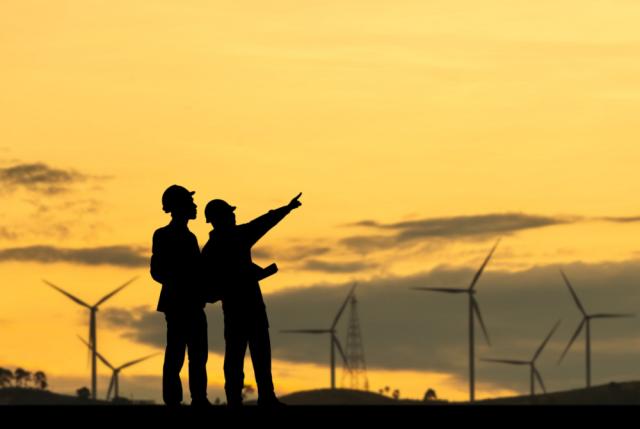
Panelists from EDP, Enbridge and AES at a recently held conference agreed that the energy transition is not slowed by energy security concerns. (Source: Shutterstock.com)
Skeptics have questioned whether hitting 2050 net-zero ambitions can be accomplished. However, some countries are giving others hope
Portugal and Brazil are two that come to mind when it comes to electricity generation for Miguel Stilwell d’Andrade, the CEO of EDP, a global utility company and energy producer that aims to be all green by 2030.
About “65% of Portugal’s energy mix is already renewables: wind, solar and hydro,” d’Andrade said during a recent energy transition conference in New York City. “Clearly, it probably could reach about 80% by 2025,” he said noting that Iberia, in general, has a high percentage of renewables, “close to 50%.”
“We are living through a massive disruption in the sector. Sometimes it feels like it’s happening in slow motion. But if you look back, [you’ll] see how fast things have changed.”—Miguel Stilwell d’Andrade, CEO, EDP and EDPR
Led by hydro, renewables also dominate Brazil’s generating capacity—accounting for about 80%. “So, it’s definitely possible to get there,” d’Andrade added of Brazil. “Yes, there are issues around intermittency, but honestly, I think those things are solvable.”
Energy transition conversations continue as energy players put plans into action to slow global warming and reduce emissions. The shift comes as part of a worldwide movement away from carbon-intensive fossil fuels and big bets on renewables.
Combining technologies, integrating energy systems and collaborating are ways to help push the world closer to its net-zero goals, according to industry leaders.
Optimizing Interconnections
Hybridization—putting together, for example, wind, solar and storage on the same connection point—could alleviate some intermittency concerns. The concept, according to d’Andrade, is taking off in Europe.
EDP is using its hybridization of renewable technologies and grid optimization strategy in Portugal, where it secured in April a 15-year power purchase agreement during the country’s floating solar auction to generate 70 megawatts (MW) at the southern Alqueva dam.
The company’s renewable arm, EDPR, is working to install additional hybrid wind capacity and solar overcapacity at the site. The project is estimated to be operational in 2025.
Speaking as a conference panelist alongside executives from electric power distributor AES Corp. and Enbridge Inc., d’Andrade explained how the grid connection capacity will help.
“The point is you ended up putting a 154-MW project on a 70-MW interconnection point,” he said. “A lot of times, the interconnection is the bottleneck to build out renewables. Actually, if you think about optimizing that interconnection point and just putting different technologies on that connection point and optimizing that cable, you can really put in a lot more renewables.”
By 2025, the Portugal-headquartered company aims to have increased its renewable capacity by 29 gigawatts (GW), increased solar capacity by 7 GW, reduced Scope 1 and Scope 2 CO2 emissions by 70% and become coal free.
“Energy security is going to have a lot to do with leaning on a lot of the old fuels and infrastructure and then transitioning a lot of that infrastructure and platforms to newer, lower-carbon energy.”—Matthew A. Akman, Senior Vice President, Strategy, Power & New Energy Technologies, Enbridge Inc.
The company decided about 15 years ago to invest heavily in renewables, d’Andrade said. As it adds capacity additions across assets in the Americas, Europe and APAC, EDP has allocated capex of 24 billion euros for the energy transition through 2025.
About “75% of our generation are going to come from renewable wind, solar or hydro,” d’Andrade said.
Integrating, Transitioning
Integrated energy systems will play a large part in the energy transition and lowering carbon emissions, according to Matthew Akman, senior vice president of strategy, power and new energy technologies for Enbridge.
“We’re taking existing infrastructure and then we’re using new energy and feeding into that,” Akman said, using Enbridge’s crude oil export terminal in Corpus Christi, Texas, as an example.
In Corpus Christi, the company is working on a project that will take natural gas off the pipeline system, feed it into the terminal and produce blue hydrogen—given the geology, carbon capture and storage (CCS) will be on site.
“Then, you can use the hydrogen locally for all kinds of purposes,” including for power generation, he said. “We’ll export ammonia as well. … There’s also potential on that site to build renewable power and produce green hydrogen at the same time.”
Panelists agreed that the transition is not slowed by energy security concerns. In some instances, such concerns—heightened by some countries’ high dependence on Russian gas—may have accelerated moves to diversify and transition energy sources.
“Energy security is going to have a lot to do with leaning on a lot of the old fuels and infrastructure and then transitioning a lot of that infrastructure and platforms to newer, lower-carbon energy,” Akman said.
Enbridge is perhaps most known for its pipelines, but the Canada-based company has been transitioning its business by taking stakes in onshore and offshore wind farms, solar farms, hydrogen projects and renewable natural gas projects.
“Only customers can lead us to where they want to go.”—Julian Nebreda, Executive Vice President and President, U.S. & Global Business Lines, The AES Corp.
Besides renewables, Akman said he sees the biggest opportunities in CCS and hydrogen.
“In any scenario, you can’t eliminate oil and gas from the energy system globally any time soon and maintain energy reliability, but you still have to get to net-zero,” he said. “The only way you’re going to be able to do that is with a lot of investment in carbon capture and storage.
“On hydrogen,” he added. “The technology’s here. We have the infrastructure. We can move it in our pipeline, at least let’s say 15% and hopefully, we can grow that. We can make net zero.”
Communicating, Collaborating
Others are also scaling up renewables. These include AES, which expects to complete more than 2 GW of new renewables capacity this year.
While the transition has become a core business for the company, Julian Nebreda, executive vice president of AES’ U.S. and global business lines, said that each market is different. For some, the future is natural gas; for others, it’s renewables.
“Only customers can lead us to where they want to go,” Nebreda said.
He stressed the importance of collaboration and listening to customers. Big Tech companies are the biggest buyers of renewables in the world by far. However, he recalled, some weren’t satisfied when it came to consumption.
“They could not see a real connection between their consumption and the renewable energy they were buying,” Nebreda said. He later explained how AES worked with tech companies to match their consumption with renewable energy sources 24/7 to ensure electrons were coming from renewables.
The company is supporting Microsoft in its ambitions to have 100% of its electricity consumption, 100% of the time, matched by zero-carbon energy purchases.
In May, AES said it expanded its prior renewable energy agreements with Microsoft, signing a 20-year agreement to source energy from its solar and storage portfolio to partially match the load at Microsoft’s California-based data centers.
AES also announced last month it entered two renewable power purchase agreements with Amazon, the largest corporate buyer of renewable energy. The retailer wants its global operations to be powered with 100% renewable energy by 2025 and reach net-zero carbon by 2040.
“We are living through a massive disruption in the sector. Sometimes it feels like it’s happening in slow motion,” d’Andrade said. “But if you look back, [you’ll] see how fast things have changed,” whether it be coal moving out and natural gas moving in or the rise of wind and solar.
Recommended Reading
Rhino Taps Halliburton for Namibia Well Work
2024-04-24 - Halliburton’s deepwater integrated multi-well construction contract for a block in the Orange Basin starts later this year.
Halliburton’s Low-key M&A Strategy Remains Unchanged
2024-04-23 - Halliburton CEO Jeff Miller says expected organic growth generates more shareholder value than following consolidation trends, such as chief rival SLB’s plans to buy ChampionX.
Deepwater Roundup 2024: Americas
2024-04-23 - The final part of Hart Energy E&P’s Deepwater Roundup focuses on projects coming online in the Americas from 2023 until the end of the decade.
Ohio Utica’s Ascent Resources Credit Rep Rises on Production, Cash Flow
2024-04-23 - Ascent Resources received a positive outlook from Fitch Ratings as the company has grown into Ohio’s No. 1 gas and No. 2 Utica oil producer, according to state data.
E&P Highlights: April 22, 2024
2024-04-22 - Here’s a roundup of the latest E&P headlines, including a standardization MoU and new contract awards.






